Consumer Behaviour and Brand Expectation in Tourism Research Proposal
VerifiedAdded on 2019/09/26
|8
|2004
|142
Report
AI Summary
This research proposal investigates consumer behaviour and brand expectation within the tourism sector, focusing on the case of Mauritius and its appeal to European tourists. The study aims to understand the relationship between destination branding, image perception, and tourist choices. It explores how consumer behaviour influences destination selection and how a strong brand image can attract target customers. The research employs a survey methodology, collecting data from European tourists at the Mauritius airport to assess their desires and views of the brand image. Findings reveal the importance of utilitarian and emotional attributes in shaping tourist decisions, and the study concludes with recommendations for destination marketers to enhance brand image and tailor marketing strategies. The research underscores the significance of aligning brand promises with actual tourist experiences and the impact of word-of-mouth on brand perception.
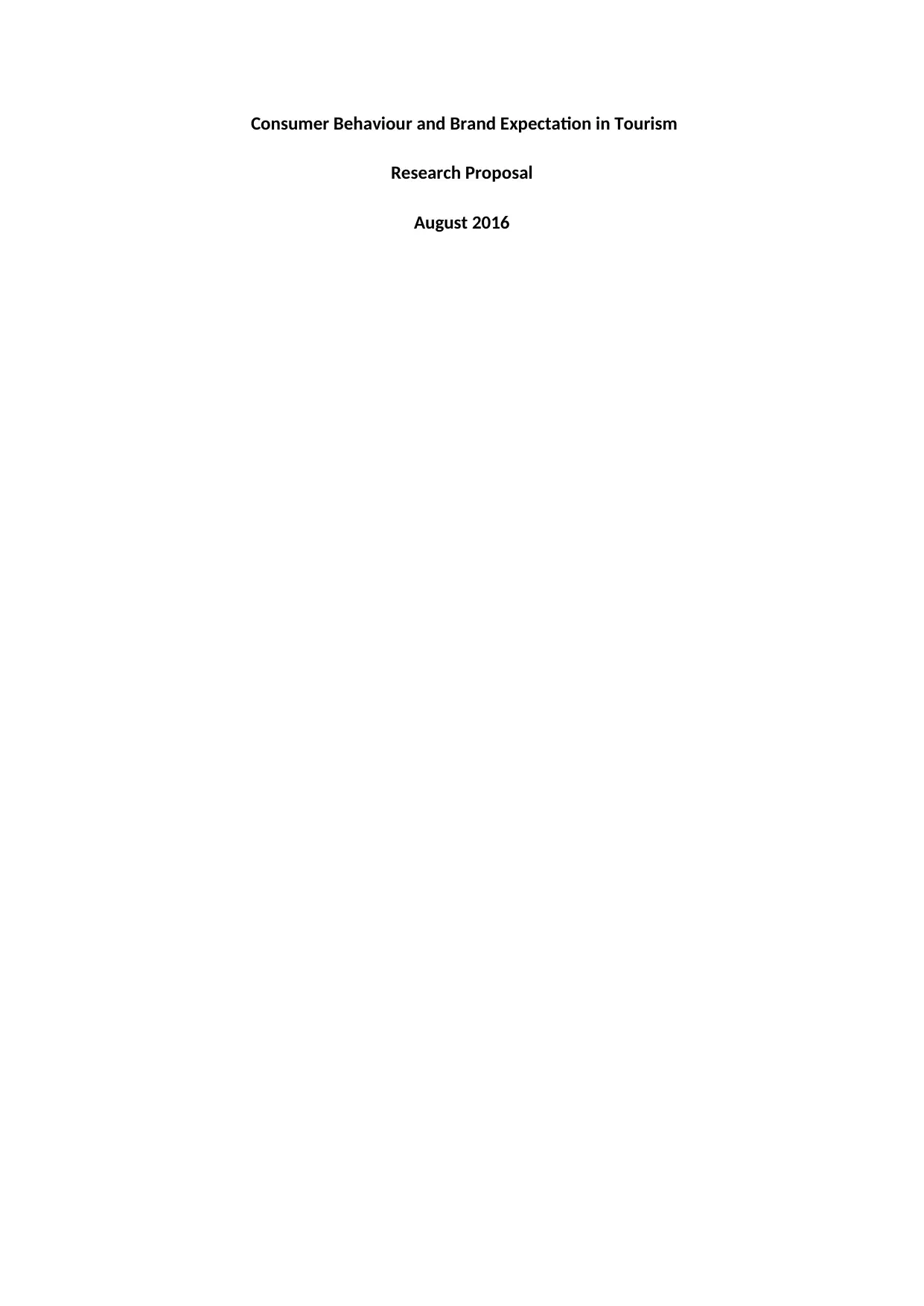
Consumer Behaviour and Brand Expectation in Tourism
Research Proposal
August 2016
Research Proposal
August 2016
Secure Best Marks with AI Grader
Need help grading? Try our AI Grader for instant feedback on your assignments.
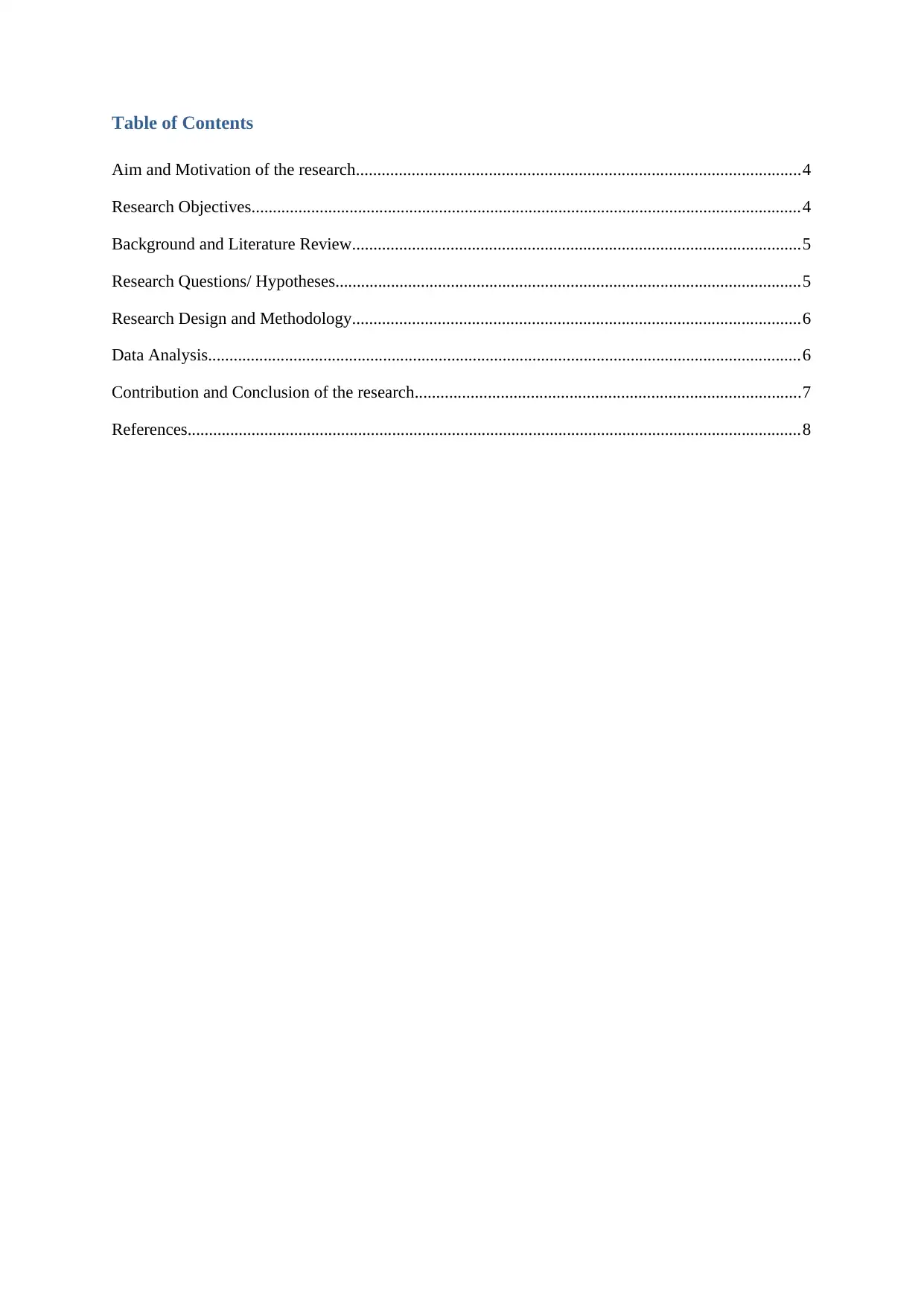
Table of Contents
Aim and Motivation of the research........................................................................................................4
Research Objectives.................................................................................................................................4
Background and Literature Review.........................................................................................................5
Research Questions/ Hypotheses.............................................................................................................5
Research Design and Methodology.........................................................................................................6
Data Analysis...........................................................................................................................................6
Contribution and Conclusion of the research..........................................................................................7
References................................................................................................................................................8
Aim and Motivation of the research........................................................................................................4
Research Objectives.................................................................................................................................4
Background and Literature Review.........................................................................................................5
Research Questions/ Hypotheses.............................................................................................................5
Research Design and Methodology.........................................................................................................6
Data Analysis...........................................................................................................................................6
Contribution and Conclusion of the research..........................................................................................7
References................................................................................................................................................8
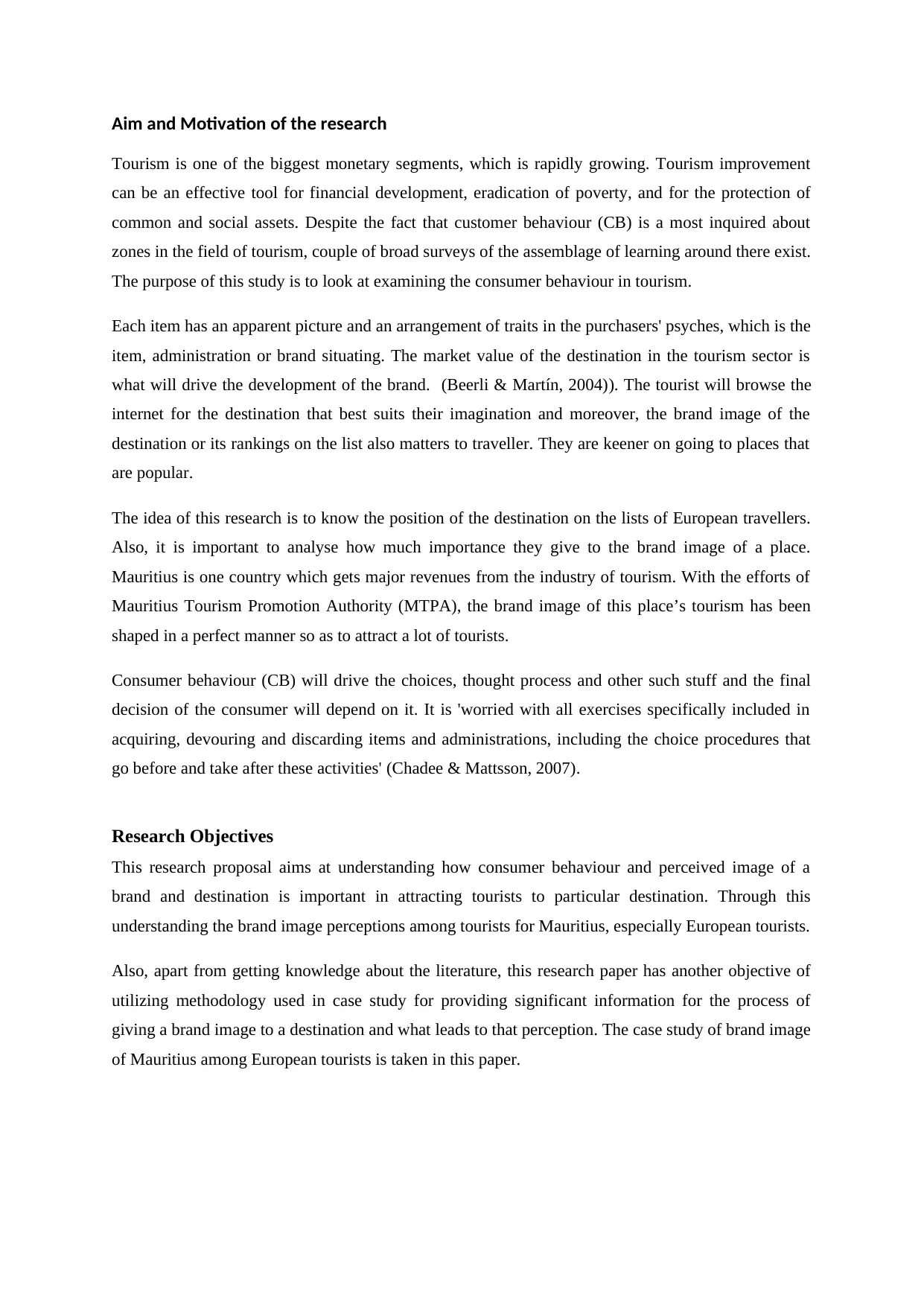
Aim and Motivation of the research
Tourism is one of the biggest monetary segments, which is rapidly growing. Tourism improvement
can be an effective tool for financial development, eradication of poverty, and for the protection of
common and social assets. Despite the fact that customer behaviour (CB) is a most inquired about
zones in the field of tourism, couple of broad surveys of the assemblage of learning around there exist.
The purpose of this study is to look at examining the consumer behaviour in tourism.
Each item has an apparent picture and an arrangement of traits in the purchasers' psyches, which is the
item, administration or brand situating. The market value of the destination in the tourism sector is
what will drive the development of the brand. (Beerli & Martín, 2004)). The tourist will browse the
internet for the destination that best suits their imagination and moreover, the brand image of the
destination or its rankings on the list also matters to traveller. They are keener on going to places that
are popular.
The idea of this research is to know the position of the destination on the lists of European travellers.
Also, it is important to analyse how much importance they give to the brand image of a place.
Mauritius is one country which gets major revenues from the industry of tourism. With the efforts of
Mauritius Tourism Promotion Authority (MTPA), the brand image of this place’s tourism has been
shaped in a perfect manner so as to attract a lot of tourists.
Consumer behaviour (CB) will drive the choices, thought process and other such stuff and the final
decision of the consumer will depend on it. It is 'worried with all exercises specifically included in
acquiring, devouring and discarding items and administrations, including the choice procedures that
go before and take after these activities' (Chadee & Mattsson, 2007).
Research Objectives
This research proposal aims at understanding how consumer behaviour and perceived image of a
brand and destination is important in attracting tourists to particular destination. Through this
understanding the brand image perceptions among tourists for Mauritius, especially European tourists.
Also, apart from getting knowledge about the literature, this research paper has another objective of
utilizing methodology used in case study for providing significant information for the process of
giving a brand image to a destination and what leads to that perception. The case study of brand image
of Mauritius among European tourists is taken in this paper.
Tourism is one of the biggest monetary segments, which is rapidly growing. Tourism improvement
can be an effective tool for financial development, eradication of poverty, and for the protection of
common and social assets. Despite the fact that customer behaviour (CB) is a most inquired about
zones in the field of tourism, couple of broad surveys of the assemblage of learning around there exist.
The purpose of this study is to look at examining the consumer behaviour in tourism.
Each item has an apparent picture and an arrangement of traits in the purchasers' psyches, which is the
item, administration or brand situating. The market value of the destination in the tourism sector is
what will drive the development of the brand. (Beerli & Martín, 2004)). The tourist will browse the
internet for the destination that best suits their imagination and moreover, the brand image of the
destination or its rankings on the list also matters to traveller. They are keener on going to places that
are popular.
The idea of this research is to know the position of the destination on the lists of European travellers.
Also, it is important to analyse how much importance they give to the brand image of a place.
Mauritius is one country which gets major revenues from the industry of tourism. With the efforts of
Mauritius Tourism Promotion Authority (MTPA), the brand image of this place’s tourism has been
shaped in a perfect manner so as to attract a lot of tourists.
Consumer behaviour (CB) will drive the choices, thought process and other such stuff and the final
decision of the consumer will depend on it. It is 'worried with all exercises specifically included in
acquiring, devouring and discarding items and administrations, including the choice procedures that
go before and take after these activities' (Chadee & Mattsson, 2007).
Research Objectives
This research proposal aims at understanding how consumer behaviour and perceived image of a
brand and destination is important in attracting tourists to particular destination. Through this
understanding the brand image perceptions among tourists for Mauritius, especially European tourists.
Also, apart from getting knowledge about the literature, this research paper has another objective of
utilizing methodology used in case study for providing significant information for the process of
giving a brand image to a destination and what leads to that perception. The case study of brand image
of Mauritius among European tourists is taken in this paper.
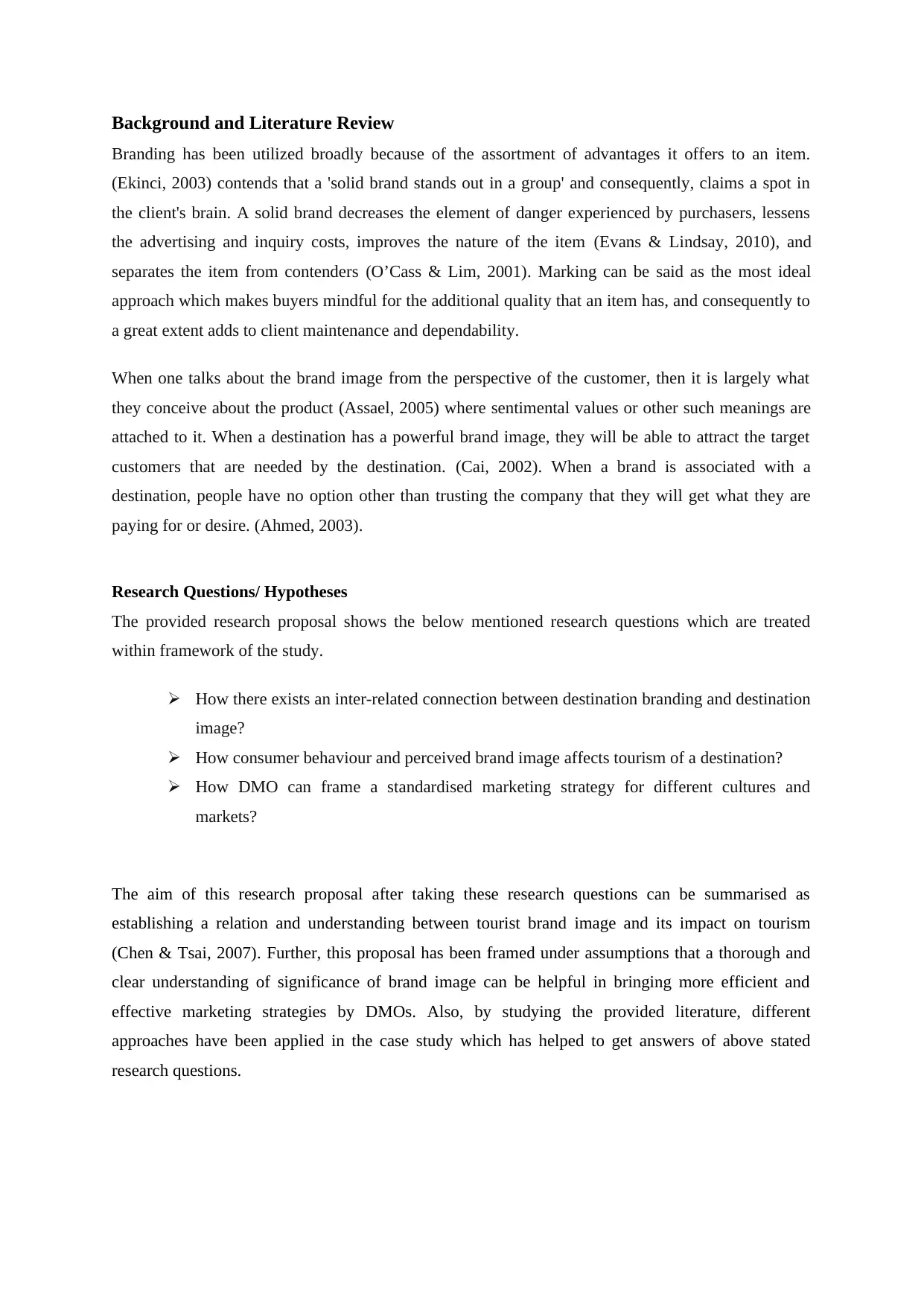
Background and Literature Review
Branding has been utilized broadly because of the assortment of advantages it offers to an item.
(Ekinci, 2003) contends that a 'solid brand stands out in a group' and consequently, claims a spot in
the client's brain. A solid brand decreases the element of danger experienced by purchasers, lessens
the advertising and inquiry costs, improves the nature of the item (Evans & Lindsay, 2010), and
separates the item from contenders (O’Cass & Lim, 2001). Marking can be said as the most ideal
approach which makes buyers mindful for the additional quality that an item has, and consequently to
a great extent adds to client maintenance and dependability.
When one talks about the brand image from the perspective of the customer, then it is largely what
they conceive about the product (Assael, 2005) where sentimental values or other such meanings are
attached to it. When a destination has a powerful brand image, they will be able to attract the target
customers that are needed by the destination. (Cai, 2002). When a brand is associated with a
destination, people have no option other than trusting the company that they will get what they are
paying for or desire. (Ahmed, 2003).
Research Questions/ Hypotheses
The provided research proposal shows the below mentioned research questions which are treated
within framework of the study.
How there exists an inter-related connection between destination branding and destination
image?
How consumer behaviour and perceived brand image affects tourism of a destination?
How DMO can frame a standardised marketing strategy for different cultures and
markets?
The aim of this research proposal after taking these research questions can be summarised as
establishing a relation and understanding between tourist brand image and its impact on tourism
(Chen & Tsai, 2007). Further, this proposal has been framed under assumptions that a thorough and
clear understanding of significance of brand image can be helpful in bringing more efficient and
effective marketing strategies by DMOs. Also, by studying the provided literature, different
approaches have been applied in the case study which has helped to get answers of above stated
research questions.
Branding has been utilized broadly because of the assortment of advantages it offers to an item.
(Ekinci, 2003) contends that a 'solid brand stands out in a group' and consequently, claims a spot in
the client's brain. A solid brand decreases the element of danger experienced by purchasers, lessens
the advertising and inquiry costs, improves the nature of the item (Evans & Lindsay, 2010), and
separates the item from contenders (O’Cass & Lim, 2001). Marking can be said as the most ideal
approach which makes buyers mindful for the additional quality that an item has, and consequently to
a great extent adds to client maintenance and dependability.
When one talks about the brand image from the perspective of the customer, then it is largely what
they conceive about the product (Assael, 2005) where sentimental values or other such meanings are
attached to it. When a destination has a powerful brand image, they will be able to attract the target
customers that are needed by the destination. (Cai, 2002). When a brand is associated with a
destination, people have no option other than trusting the company that they will get what they are
paying for or desire. (Ahmed, 2003).
Research Questions/ Hypotheses
The provided research proposal shows the below mentioned research questions which are treated
within framework of the study.
How there exists an inter-related connection between destination branding and destination
image?
How consumer behaviour and perceived brand image affects tourism of a destination?
How DMO can frame a standardised marketing strategy for different cultures and
markets?
The aim of this research proposal after taking these research questions can be summarised as
establishing a relation and understanding between tourist brand image and its impact on tourism
(Chen & Tsai, 2007). Further, this proposal has been framed under assumptions that a thorough and
clear understanding of significance of brand image can be helpful in bringing more efficient and
effective marketing strategies by DMOs. Also, by studying the provided literature, different
approaches have been applied in the case study which has helped to get answers of above stated
research questions.
Secure Best Marks with AI Grader
Need help grading? Try our AI Grader for instant feedback on your assignments.
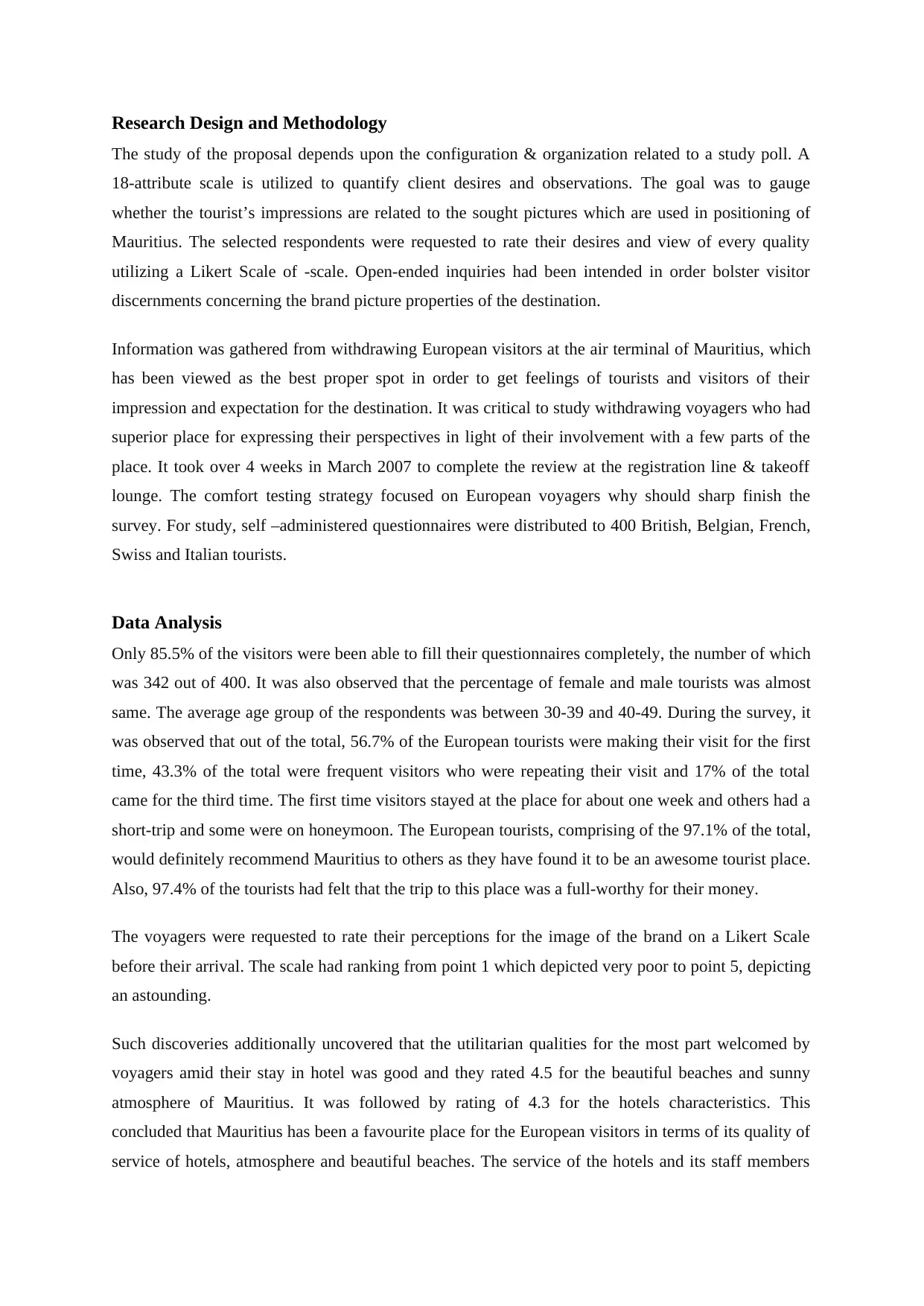
Research Design and Methodology
The study of the proposal depends upon the configuration & organization related to a study poll. A
18-attribute scale is utilized to quantify client desires and observations. The goal was to gauge
whether the tourist’s impressions are related to the sought pictures which are used in positioning of
Mauritius. The selected respondents were requested to rate their desires and view of every quality
utilizing a Likert Scale of -scale. Open-ended inquiries had been intended in order bolster visitor
discernments concerning the brand picture properties of the destination.
Information was gathered from withdrawing European visitors at the air terminal of Mauritius, which
has been viewed as the best proper spot in order to get feelings of tourists and visitors of their
impression and expectation for the destination. It was critical to study withdrawing voyagers who had
superior place for expressing their perspectives in light of their involvement with a few parts of the
place. It took over 4 weeks in March 2007 to complete the review at the registration line & takeoff
lounge. The comfort testing strategy focused on European voyagers why should sharp finish the
survey. For study, self –administered questionnaires were distributed to 400 British, Belgian, French,
Swiss and Italian tourists.
Data Analysis
Only 85.5% of the visitors were been able to fill their questionnaires completely, the number of which
was 342 out of 400. It was also observed that the percentage of female and male tourists was almost
same. The average age group of the respondents was between 30-39 and 40-49. During the survey, it
was observed that out of the total, 56.7% of the European tourists were making their visit for the first
time, 43.3% of the total were frequent visitors who were repeating their visit and 17% of the total
came for the third time. The first time visitors stayed at the place for about one week and others had a
short-trip and some were on honeymoon. The European tourists, comprising of the 97.1% of the total,
would definitely recommend Mauritius to others as they have found it to be an awesome tourist place.
Also, 97.4% of the tourists had felt that the trip to this place was a full-worthy for their money.
The voyagers were requested to rate their perceptions for the image of the brand on a Likert Scale
before their arrival. The scale had ranking from point 1 which depicted very poor to point 5, depicting
an astounding.
Such discoveries additionally uncovered that the utilitarian qualities for the most part welcomed by
voyagers amid their stay in hotel was good and they rated 4.5 for the beautiful beaches and sunny
atmosphere of Mauritius. It was followed by rating of 4.3 for the hotels characteristics. This
concluded that Mauritius has been a favourite place for the European visitors in terms of its quality of
service of hotels, atmosphere and beautiful beaches. The service of the hotels and its staff members
The study of the proposal depends upon the configuration & organization related to a study poll. A
18-attribute scale is utilized to quantify client desires and observations. The goal was to gauge
whether the tourist’s impressions are related to the sought pictures which are used in positioning of
Mauritius. The selected respondents were requested to rate their desires and view of every quality
utilizing a Likert Scale of -scale. Open-ended inquiries had been intended in order bolster visitor
discernments concerning the brand picture properties of the destination.
Information was gathered from withdrawing European visitors at the air terminal of Mauritius, which
has been viewed as the best proper spot in order to get feelings of tourists and visitors of their
impression and expectation for the destination. It was critical to study withdrawing voyagers who had
superior place for expressing their perspectives in light of their involvement with a few parts of the
place. It took over 4 weeks in March 2007 to complete the review at the registration line & takeoff
lounge. The comfort testing strategy focused on European voyagers why should sharp finish the
survey. For study, self –administered questionnaires were distributed to 400 British, Belgian, French,
Swiss and Italian tourists.
Data Analysis
Only 85.5% of the visitors were been able to fill their questionnaires completely, the number of which
was 342 out of 400. It was also observed that the percentage of female and male tourists was almost
same. The average age group of the respondents was between 30-39 and 40-49. During the survey, it
was observed that out of the total, 56.7% of the European tourists were making their visit for the first
time, 43.3% of the total were frequent visitors who were repeating their visit and 17% of the total
came for the third time. The first time visitors stayed at the place for about one week and others had a
short-trip and some were on honeymoon. The European tourists, comprising of the 97.1% of the total,
would definitely recommend Mauritius to others as they have found it to be an awesome tourist place.
Also, 97.4% of the tourists had felt that the trip to this place was a full-worthy for their money.
The voyagers were requested to rate their perceptions for the image of the brand on a Likert Scale
before their arrival. The scale had ranking from point 1 which depicted very poor to point 5, depicting
an astounding.
Such discoveries additionally uncovered that the utilitarian qualities for the most part welcomed by
voyagers amid their stay in hotel was good and they rated 4.5 for the beautiful beaches and sunny
atmosphere of Mauritius. It was followed by rating of 4.3 for the hotels characteristics. This
concluded that Mauritius has been a favourite place for the European visitors in terms of its quality of
service of hotels, atmosphere and beautiful beaches. The service of the hotels and its staff members
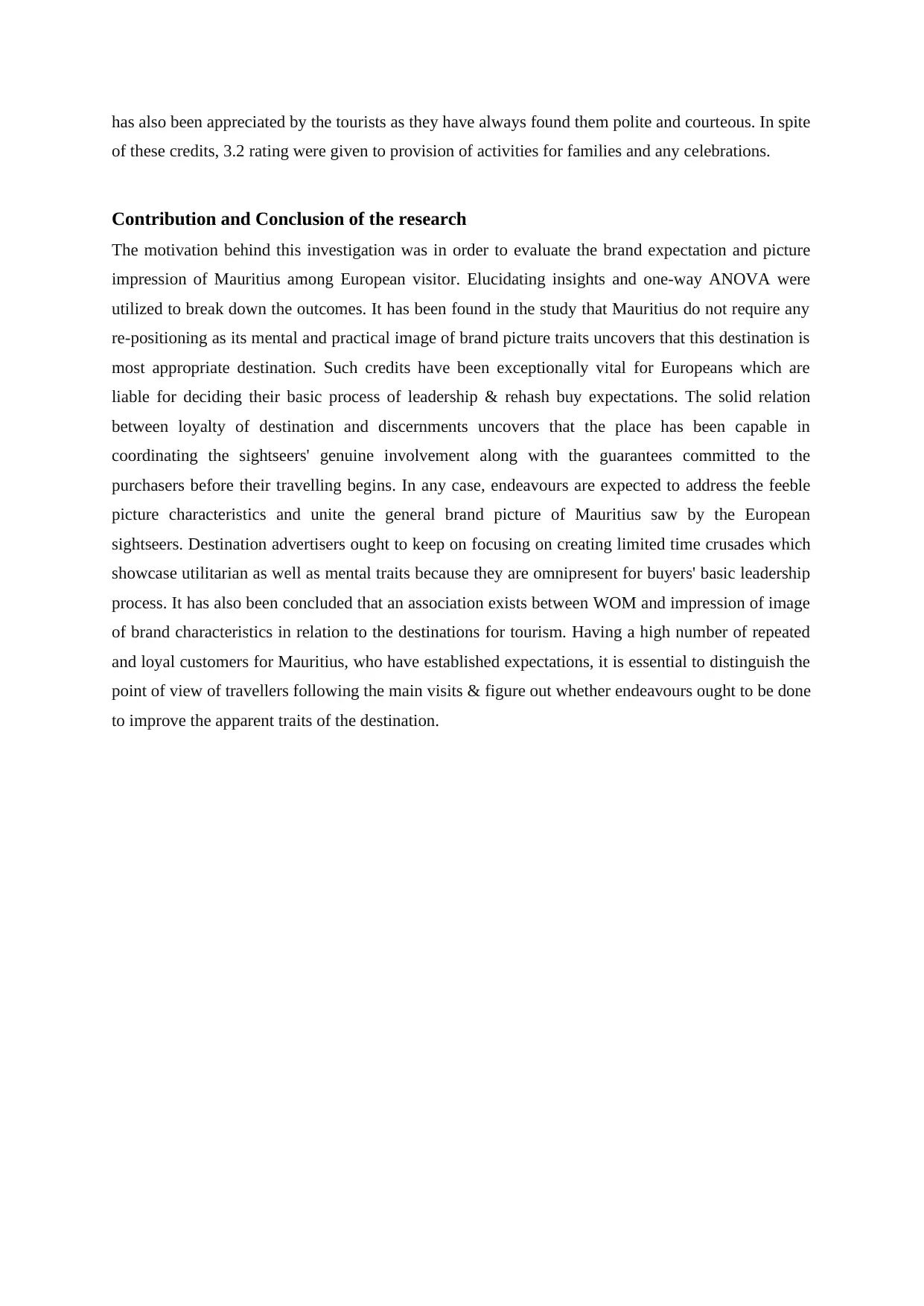
has also been appreciated by the tourists as they have always found them polite and courteous. In spite
of these credits, 3.2 rating were given to provision of activities for families and any celebrations.
Contribution and Conclusion of the research
The motivation behind this investigation was in order to evaluate the brand expectation and picture
impression of Mauritius among European visitor. Elucidating insights and one-way ANOVA were
utilized to break down the outcomes. It has been found in the study that Mauritius do not require any
re-positioning as its mental and practical image of brand picture traits uncovers that this destination is
most appropriate destination. Such credits have been exceptionally vital for Europeans which are
liable for deciding their basic process of leadership & rehash buy expectations. The solid relation
between loyalty of destination and discernments uncovers that the place has been capable in
coordinating the sightseers' genuine involvement along with the guarantees committed to the
purchasers before their travelling begins. In any case, endeavours are expected to address the feeble
picture characteristics and unite the general brand picture of Mauritius saw by the European
sightseers. Destination advertisers ought to keep on focusing on creating limited time crusades which
showcase utilitarian as well as mental traits because they are omnipresent for buyers' basic leadership
process. It has also been concluded that an association exists between WOM and impression of image
of brand characteristics in relation to the destinations for tourism. Having a high number of repeated
and loyal customers for Mauritius, who have established expectations, it is essential to distinguish the
point of view of travellers following the main visits & figure out whether endeavours ought to be done
to improve the apparent traits of the destination.
of these credits, 3.2 rating were given to provision of activities for families and any celebrations.
Contribution and Conclusion of the research
The motivation behind this investigation was in order to evaluate the brand expectation and picture
impression of Mauritius among European visitor. Elucidating insights and one-way ANOVA were
utilized to break down the outcomes. It has been found in the study that Mauritius do not require any
re-positioning as its mental and practical image of brand picture traits uncovers that this destination is
most appropriate destination. Such credits have been exceptionally vital for Europeans which are
liable for deciding their basic process of leadership & rehash buy expectations. The solid relation
between loyalty of destination and discernments uncovers that the place has been capable in
coordinating the sightseers' genuine involvement along with the guarantees committed to the
purchasers before their travelling begins. In any case, endeavours are expected to address the feeble
picture characteristics and unite the general brand picture of Mauritius saw by the European
sightseers. Destination advertisers ought to keep on focusing on creating limited time crusades which
showcase utilitarian as well as mental traits because they are omnipresent for buyers' basic leadership
process. It has also been concluded that an association exists between WOM and impression of image
of brand characteristics in relation to the destinations for tourism. Having a high number of repeated
and loyal customers for Mauritius, who have established expectations, it is essential to distinguish the
point of view of travellers following the main visits & figure out whether endeavours ought to be done
to improve the apparent traits of the destination.
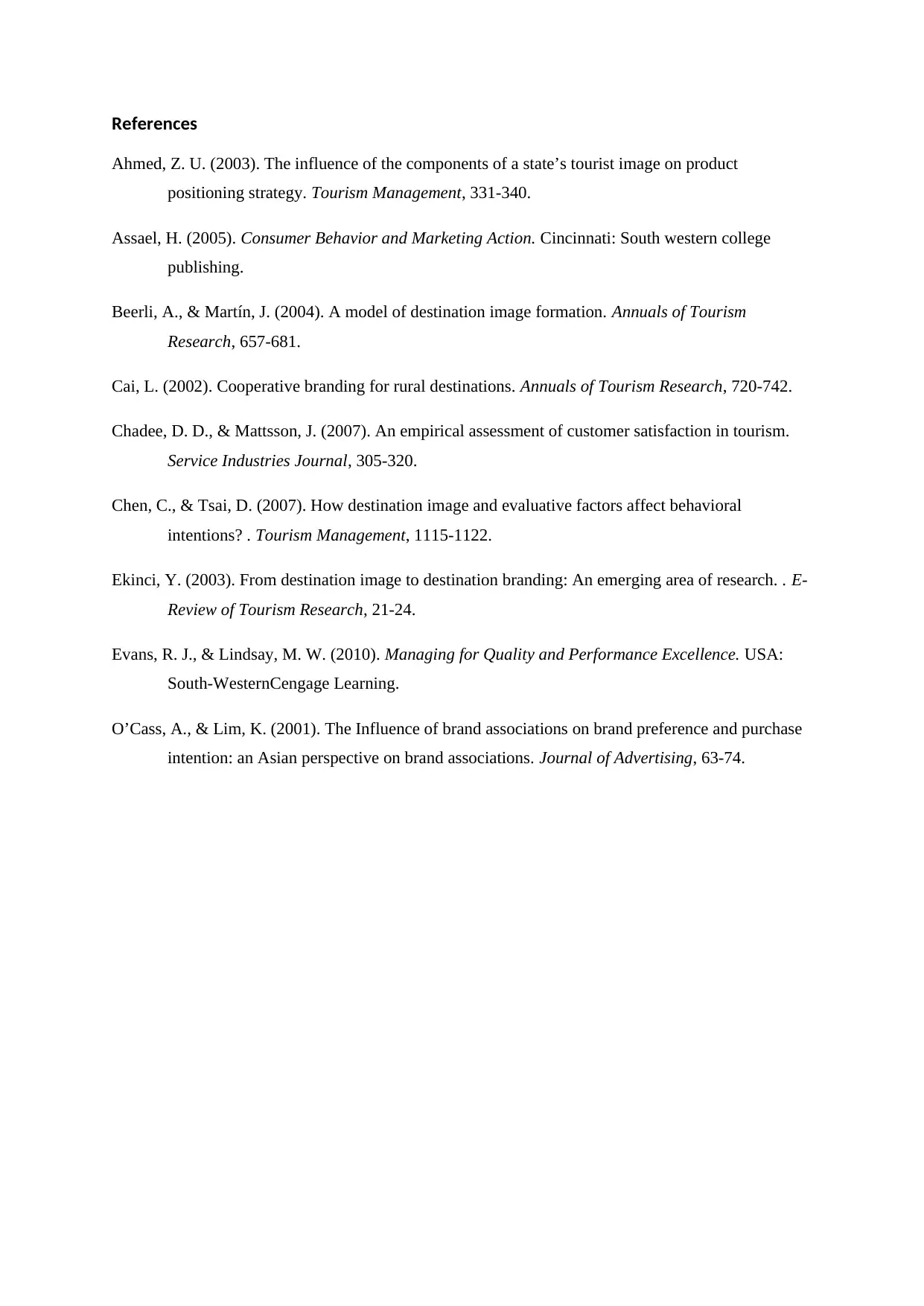
References
Ahmed, Z. U. (2003). The influence of the components of a state’s tourist image on product
positioning strategy. Tourism Management, 331-340.
Assael, H. (2005). Consumer Behavior and Marketing Action. Cincinnati: South western college
publishing.
Beerli, A., & Martín, J. (2004). A model of destination image formation. Annuals of Tourism
Research, 657-681.
Cai, L. (2002). Cooperative branding for rural destinations. Annuals of Tourism Research, 720-742.
Chadee, D. D., & Mattsson, J. (2007). An empirical assessment of customer satisfaction in tourism.
Service Industries Journal, 305-320.
Chen, C., & Tsai, D. (2007). How destination image and evaluative factors affect behavioral
intentions? . Tourism Management, 1115-1122.
Ekinci, Y. (2003). From destination image to destination branding: An emerging area of research. . E-
Review of Tourism Research, 21-24.
Evans, R. J., & Lindsay, M. W. (2010). Managing for Quality and Performance Excellence. USA:
South-WesternCengage Learning.
O’Cass, A., & Lim, K. (2001). The Influence of brand associations on brand preference and purchase
intention: an Asian perspective on brand associations. Journal of Advertising, 63-74.
Ahmed, Z. U. (2003). The influence of the components of a state’s tourist image on product
positioning strategy. Tourism Management, 331-340.
Assael, H. (2005). Consumer Behavior and Marketing Action. Cincinnati: South western college
publishing.
Beerli, A., & Martín, J. (2004). A model of destination image formation. Annuals of Tourism
Research, 657-681.
Cai, L. (2002). Cooperative branding for rural destinations. Annuals of Tourism Research, 720-742.
Chadee, D. D., & Mattsson, J. (2007). An empirical assessment of customer satisfaction in tourism.
Service Industries Journal, 305-320.
Chen, C., & Tsai, D. (2007). How destination image and evaluative factors affect behavioral
intentions? . Tourism Management, 1115-1122.
Ekinci, Y. (2003). From destination image to destination branding: An emerging area of research. . E-
Review of Tourism Research, 21-24.
Evans, R. J., & Lindsay, M. W. (2010). Managing for Quality and Performance Excellence. USA:
South-WesternCengage Learning.
O’Cass, A., & Lim, K. (2001). The Influence of brand associations on brand preference and purchase
intention: an Asian perspective on brand associations. Journal of Advertising, 63-74.
Paraphrase This Document
Need a fresh take? Get an instant paraphrase of this document with our AI Paraphraser

1 out of 8
Related Documents
Your All-in-One AI-Powered Toolkit for Academic Success.
+13062052269
info@desklib.com
Available 24*7 on WhatsApp / Email
![[object Object]](/_next/static/media/star-bottom.7253800d.svg)
Unlock your academic potential
© 2024 | Zucol Services PVT LTD | All rights reserved.





